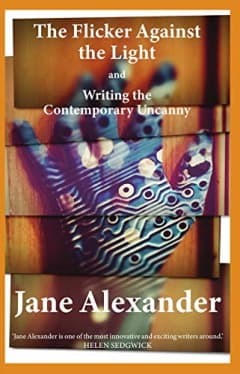
The Flicker Against the Light and Writing the Contemporary Uncanny by Jane Alexander
(Luna Press Publishing, 2021)
Reviewed by Ksenia Shcherbino
The Flicker Against the Light and Writing the Contemporary Uncanny is a collection of strange and haunting stories. Or, giving word to Jane Alexander herself, these stories ‘are specific to the technologies of our age, and simultaneously recognisable as instances of the uncanny…with doubles, hauntings, confusions of the living and the dead, the return of the repressed and many other uncanny tropes and topos given contemporary expression.’
There’s not much character or plot development in this book. If anything, these stories are slices of life, portraits of here and now with all the blindness and misunderstanding of a close-up. They are populated with characters betwixt and between different stages of life and reality, in the liminal states of chronic illness (‘Chronic’ and ‘Lag’), pregnancy (‘Now Here’), death (‘Meat’), loss of identity (‘Dolly’) or inability to distinguish between memory, reality and hallucination (‘A Sequence’ and ‘Candlemaker Row’). Mostly, they are women (as so often with liminal stories, women are frequently trapped on the thresholds of being). A pregnant woman develops a dangerous affinity with her home's bio-technological extension. Another woman volunteers to walk a recreation of a city where she used to live with her deceased partner (‘Candlemaker Row’). A nurse taking care of patients in persistent vegetative state and filling in the life story of a young boy whose mother has lost hope of his recovery—retracing the story of her dead son of the same age (‘Saints’). Yet another woman, chronically ill, develops a close friendship with a cloud-based voice service (‘Chronic’). An amputee muses that every step she takes is stealing time from her: ‘Once she’s started to count [the seconds], to add up all those fractions and fragments, she began to understand how much time she was losing.’ (‘The Lag’). A young man trading his blood and vital force for rent and love.
There are stories about coping with grief and loss, about loneliness in the age of AI and constant newsfeed updates that deprive our lives of any sort of privacy (‘You The Story’), about connectivity and inability to connect. In the age of constantly narrowing focus that makes us blind to our own condition, both physical and metaphorical, in the age of drowning in the ever-increasing information feeds, that makes us incapable of distinguishing between things that are important and things that are not. No wonder blindness and side effects of its cure play and important role in a few stories (‘A Sequence’).
Two main topics that keep resurging in Alexander’s stories, are that of coping with loss, and that of fitting in, the fragmentation of memories and the fragmentation of identity. The boundaries between first- and third-person singular are blurred. We are never quite sure who is speaking to us, stories are narrated from multiple perspectives. As a voice assistant reminds its master, ‘before I can give you an answer, you must ask me a question.’ But are we—both readers and narrators—ever capable of finding the right words? As the nurse puts in another story, what questions do you ask a person in a vegetative state?
And that’s where science (or science fiction) steps in. It offers solutions for questions we can’t bring ourselves to ask. Some of the options offered by Alexander already exist (cloning, voice assistants, advanced treatment methods), some are a believable possibility in the nearest future (holographic reconstruction of a city complete with smells and sounds). Yes, you can clone and bring back the dead. Yes, you can cure diseases with stem cells. But what are the costs you will pay? What are the side effects?
Science, as one of the characters says, is one per cent triumph and 99 per cent disappointment. Most experiments fail, most epiphanies prove wrong. Still there is hope. There is magic in the interstices, in the uncertainty of the answer, in all the possibilities before the final choice is made. These possibilities haunt our lives as ghosts, as floaters, as hallucinations, as white noise. In ‘The Hatayama Code’ a project was intended to generate a sound map of world wide web, with volume and duration corresponding to the total number and length of visits to the website. But, as a side effect, it also had an anomaly, a top layer of data over the music, that no one could explain. A glitch? A warning? A message from Heavens?
The book ends with an essay on the uncanny. Jane Alexander confesses she has been looking for a certain quality in texts, both as a reader and a writer,—she names it uncertainty, an act of ‘reaching, as a writer, towards something I don’t quite recognize, or with finding a way to speak about something that hovers just at the edge of understanding.’
I look for a similar quality, though in my research, I call it liminality, and I read those stories as threshold narratives—not necessarily poised on the threshold of terror and uneasiness, but more as a logical haunting, an ever-escaping answer, an open-ended question. There are no clues, and no correct readings, as if these stories are puzzles with pieces missing or not fitting in, a fact that might upset a more logical reader, but fascinates anyone who looks out for the unusual. I am a strange collection of symptoms, one of the characters introduces herself. This can be applied to the book itself—it is an exquisite collection of symptoms of our age, with its insecurities and paranoia, its hauntings and frustrations, failed experiments and big dreams, with the absolute certainty—and a similar absolute dread—that everything is possible, and yet nothing is quite as it should be. A highly recommended read.
Review from BSFA Review 19 - Download your copy here.
